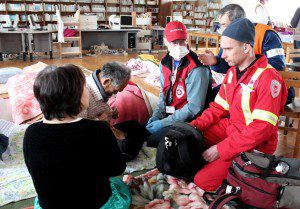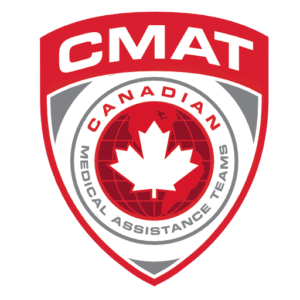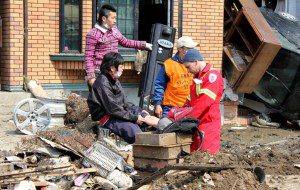CMAT Japan Deployment: March 26 update

CMAT physician Dr. Carl Jarvis, and paramedic Martin Metz assess and treat patients in an evacuation centre near Ishnomaki.
Saturday, March 26, 2011 – Ishinomaki, Miyagi, Japan- The CMAT Medical Team has had a busy last few days. The team has been splitting into smaller groups of 4 to 5 individuals, and surveying the city of Ishinomaki and outlying coastal villages within a 30km radius.
Yesterday, a 5-member strike team collaborated with the Japanese military in the coastal town of Onagawa, approximately 15km east of Ishinomaki. The team was asked to assist with the search and recovery of victims in this small community which was flattened by the tsunami. Working their way through broken homes, rubble and bamboo forests, the team reported that in this area the waves were well over 100 feet high and deposited debris into the branches of tall trees. Of the estimated 15,000 people who lived in this community before the tsunami, only about 300 survived the disaster, and are now being housed in an evacuation centre on higher ground.
The remainder of the team spent the day visiting evacuation centres in several small villages along the coast, and providing medical care to the evacuees. The situation in Japan is reminiscent of CMAT’s first deployment in response to the Indian Ocean tsunami of 2004. Just like Indonesia, countless numbers of people in Japan perished in the disaster, and those who did survive, escaped largely unharmed. The medical team visiting evacuation centres provided primary medical care and first aid to some of the evacuees, as the few patients who survived with major or significant injuries had already been treated. Many of the patients that the team saw were elderly, and had chronic illnesses like diabetes and high blood pressure.

CMAT Team Leader David Johnson, and several members of the team assist the Japanese military with Search and Recovery efforts in the town of Onagawa. The wave was over 100ft high in this town.
The initial acute phase of the disaster is now transitioning to the chronic recovery phase. The primary objective of providing initial disaster relief has been met, and much of the need now will be longer-term shelter and reconstruction planning. This requires long-term funding from other organizations who can commit the necessary resources and time.
Participation in this relief effort has been a good experience for CMAT and has provided invaluable lessons to enhance the effectiveness of future missions. Although preparation and safety of our teams is essential, disasters always result in the unexpected, and flexibility is needed to meet our objectives.


